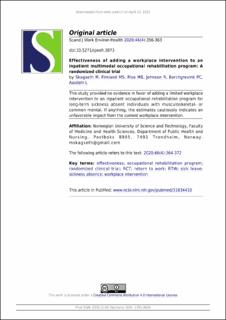| dc.contributor.author | Skagseth, Martin | |
| dc.contributor.author | Fimland, Marius Steiro | |
| dc.contributor.author | Rise, Marit By | |
| dc.contributor.author | Johnsen, Roar | |
| dc.contributor.author | Borchgrevink, Petter Chr. | |
| dc.contributor.author | Aasdahl, Lene | |
| dc.date.accessioned | 2021-04-28T06:53:58Z | |
| dc.date.available | 2021-04-28T06:53:58Z | |
| dc.date.created | 2019-12-16T15:12:30Z | |
| dc.date.issued | 2019 | |
| dc.identifier.issn | 0355-3140 | |
| dc.identifier.uri | https://hdl.handle.net/11250/2740008 | |
| dc.description.abstract | Objectives This study aimed to evaluate the effectiveness of a workplace intervention (WI) added to an inpatient multimodal occupational rehabilitation program (I-MORE) on sickness absence.
Methods In this researcher-blinded randomized controlled trial with parallel groups, individuals on sick leave due to musculoskeletal, unspecified- or common mental health disorders were randomized to I-MORE (N=87) or I-MORE+WI (N=88). I-MORE lasted 2+1 weeks (with one week at home in between) and consisted of "acceptance and commitment therapy", physical exercise, and work-related problem solving. The additional WI consisted of a preparatory part, a workplace meeting involving the sick-listed worker, the employer, and the primary rehabilitation therapist at the rehabilitation center, and follow-up work related to the meeting. The primary outcomes were number of sickness absence days and time until sustainable return to work (RTW) during 12 months of follow-up, measured by registry data.
Results The median number of sickness absence days during the 12-month follow-up for I-MORE was 115 days [interquartile range (IQR) 53–183] versus 130 days (IQR 81–212) for I-MORE+WI. The difference between groups was not statistically significant (P=0.084). The hazard ratio for sustainable RTW was 0.74 (95% confidence interval 0.48–1.16; P=0.192) in favor of I-MORE.
Conclusions This study provided no evidence in favor of I-MORE+WI compared to only I-MORE for long-term sickness absent individuals with musculoskeletal-, common mental- or unspecified disorders. | en_US |
| dc.language.iso | eng | en_US |
| dc.publisher | NOROSH | en_US |
| dc.relation.uri | https://www.sjweh.fi/show_abstract.php?abstract_id=3873 | |
| dc.rights | Navngivelse 4.0 Internasjonal | * |
| dc.rights.uri | http://creativecommons.org/licenses/by/4.0/deed.no | * |
| dc.title | Effectiveness of adding a workplace intervention to an inpatient multimodal occupational rehabilitation program: A randomized clinical trial | en_US |
| dc.type | Peer reviewed | en_US |
| dc.type | Journal article | en_US |
| dc.description.version | publishedVersion | en_US |
| dc.source.journal | Scandinavian Journal of Work, Environment and Health | en_US |
| dc.identifier.doi | 10.5271/sjweh.3873 | |
| dc.identifier.cristin | 1761382 | |
| dc.relation.project | Norges forskningsråd: 90101700 | en_US |
| cristin.ispublished | true | |
| cristin.fulltext | original | |
| cristin.qualitycode | 1 | |

